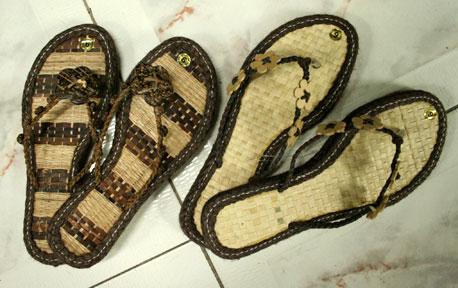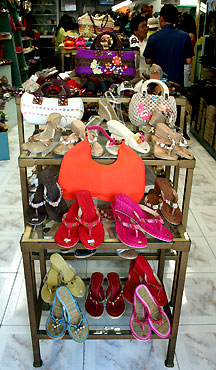Flip-Flops, Liliw
Style
A trip in the town
of Liliw would give flip-flop lovers a fresh view about this new craze.
The homegrown, native slippers are hand-made, piece-by-piece, by the
town’s oldest and finest-skilled shoemakers.
BY DABET CASTANEDA
Bulatlat
PHOTOS BY DABET CASTAÑEDA
 |
LILIW’S
SLIPPERS: The town of Liliw, Laguna is particularly famous for its
intricately-designed slippers, with soles made of a native material
called tukig and straps made of abaca |
LILIW, Laguna –
Even old-fashioned grandmothers would agree that flip-flops are the
latest things in footwear all over the country in the last five years.
Mostly rubber-made, their wide range of colors - from black, gray, moss
green and maroon to brighter shades of red, pink, yellow, orange, royal
blue and neon green - would fit to a wide range of end users - from the
street kids and market vendors to students, young professionals or just
about anybody who would want to be comfy when traveling, mall-hopping,
going to school, office or just taking a walk down the street.
A trip in this town
(110 km south of Manila via Sta. Cruz, the province capital of Laguna)
though would give flip-flop lovers a fresh view about this new craze.
The homegrown, native slippers hand-made, piece-by-piece, by the town’s
oldest and finest-skilled shoemakers, are known here by the local name
tsinelas.
 Exciting designs
Exciting designs
Abaca and native
beads dominate the designs of footwear products here but there are also
imported beads and soles from China, one of the store owners said.
The native
accessories come in different striking and trendy colors such as hot
pink, neon green, bright yellow and dazzling orange combined with brown
and cream, the abaca’s natural color. Straps or the entrada are
mostly made of abaca or felt cloth.
The soles are also
mostly made of abaca or tikog (woven mat). My most favorite
design has a tikog sole and thin abaca straps with coconut shells
as accessories.
The designs are
originally made by the manufacturers inspired by imported shoes and
slippers.
Shoemakers
Forty-nine-year-old
Renato Capili is a native of Sta. Cruz town, same province. He has been
a shoemaker for 28 years here Liliw, a skill he learned from his elders.
He is single, he said, and spends most of his time doing different
styles of slippers mostly made of native accessories like abaca from
Bicol, beads from Divisoria in Manila and ready-made cork soles from
Biñan, another town in Laguna 35 kms south of Manila.
On the other hand,
Gin Sarmiento, 42, started working as shoemaker in Biñan for 13 years.
He transferred to Liliw two years ago, “kasi matumal na ang
industriya ng tsinelas sa Biñan dahil sa pagpasok ng mga imported na
produkto” (The industry has slackened in Biñan because of the influx
of imported slippers), he sighed.
Shoemakers here are
paid P30 (flats) or P35 (with heels) per pair but P1 goes to the fabric
cutter, therefore, the actual pay per pair is P29 or P34 depending on
the style.
Old industry
Tsinelas
production in this town started as early as 1960s, said Emma Camello of
the Socialite Footwear, one of the pioneers in the footwear business
here. Socialite Footwear is now operated by the family’s third
generation heirs.
 Manufacturers here
were always in tight competition with neighboring town Biñan until the
late 1990s when imported shoes and slippers flooded the town market
causing the decline of the local footwear industry there.
Manufacturers here
were always in tight competition with neighboring town Biñan until the
late 1990s when imported shoes and slippers flooded the town market
causing the decline of the local footwear industry there.
Although Liliw
footwear products are now popular in Metro Manila malls and flee markets
and boasts of an international market in China, operations, production
and storage are still backward. Production houses are literally in the
backyard where shoemakers each have their own cubicles that serve as
work places.
Learning from the
Biñan experience, footwear manufacturers in Liliw have formed an
association and have agreed to ban all imported footwear products from
this town. Bulatlat
BACK TO
TOP ■
PRINTER-FRIENDLY VERSION ■
COMMENT
© 2007 Bulatlat
■
Alipato Publications
Permission is granted to reprint or redistribute this article, provided
its author/s and Bulatlat are properly credited and notified.